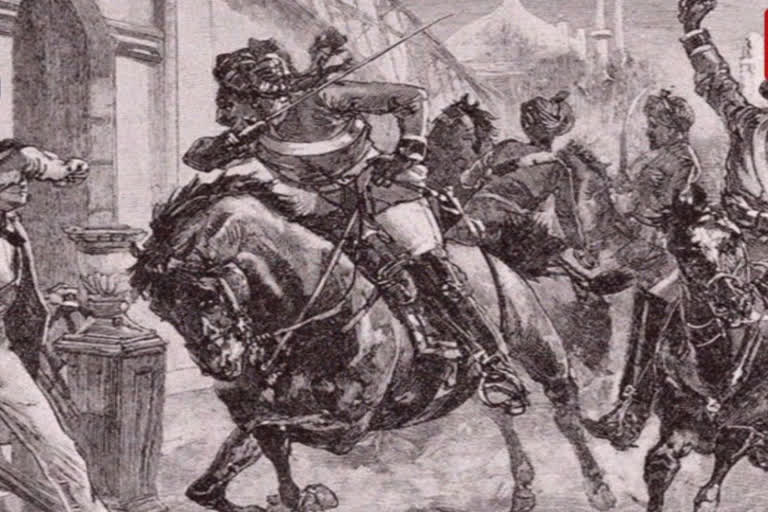Ajmer: Among the many unsung heroes lost in the glorious battle of freedom from British-occupied India, Arjun Lal Sethi from Rajasthan has the last remnants of his valor remembered by a mere board on the outskirts of Ajmer. It is said that Sethi's contribution to the freedom fight was so conspicuous that at one point the father of the nation, Mahatma Gandhi himself had gone to meet him personally.
"It is really unfortunate that there is no mention of this meeting anywhere in the recorded history. Arjun Lal Sethi's contribution to the freedom fight has not gotten the recognition it deserves," says Dr. Shrigopal Baheti, the President of Ajmer District Gandhi Darshan Samiti.
Arjun Lal Sethi, who is considered the spearhead of the armed revolution in Rajasthan, took over the reins of the Ajmer-Merwara Provincial Congress in Rajasthan in 1922-23 and led the light of the revolution from Ajmer. He played a crucial role in opposing the partition of Bengal in the year 1905. In the year 1907, he also established a school in Ajmer under the banner name of Jain Education Society to facilitate revolutionary training for the youth.
One year down the line, this school was shifted to Jaipur under the name of Jain Vardhman Pathshala. The revolutionaries like Zorawar Singh Barhat and Pratap Singh, who threw bombs on the procession of Governor-General Lord Hardinge in Delhi in December 1912, were also trained in this school. It was Sethi who had planned this bomb incident which was successfully executed on December 12 in 1912.
Sethi had also made excellent use of the geographical aspects of Ajmer at the time. There was a secret passage on a hill in Ajmer with a huge space in the middle of it, which was used by the revolutionaries to prepare and export bombs. "We used to make bombs and supply them among other revolutionaries across the nation. We were all trained and used to do all sorts of things," Shobhagchand Gaharwar says, remembering his olden days as an Indian Army soldier and a revolutionary.
Ajmer, being one of the most important union territories in Rajasthan during the British rule in India, was the epicenter of revolutionary activities. Consequently, all the British officials in Ajmer stayed quite vigilant about the day-to-day activities here. The echo of every happening here traveled with the wind to reach the British ears in no time.
Among several spots in the city, the Gol Chakkar (circle) located in the heart of the city has witnessed both the valor and the ordeals of the revolutionaries who fought with blood and sweat to free the country from the chains of slavery along with Arjun Lal Sethi. Once during a meeting against the British, bullets were also fired at the Gol Chakkar.
"The Gol Chakkar in Kesarganj of Ajmer was the main point of operation for the freedom fighters in Ajmer. The entire freedom movement of Ajmer-Merwara was guided by Ajmer," tells Dr. Shrigopal Baheti. Two of the most important religious places for both the Hindus and Muslims - the Brahma Temple of Pushkar and the Dargah of Khwaja Moinuddin Chishti - are also situated in Ajmer. The revolutionaries, therefore, used to come to Ajmer in the guise of devotees, and return after serving their purposes. Several leaders including Netaji Subhash Chandra Bose, Chandrashekhar Azad, and Bhagat Singh had stayed in Ajmer. Azad had reportedly stayed in a hut on a hill located in Ajmer, while Bhagat Singh had stayed in the Beawar are in Ajmer.
Arjun Lal Sethi had prepared the young revolutionaries to fight on every front. On 20 March 1913, Sethi was sent to jail in connection with the murder of a Mahant, followed by 5 years of imprisonment on August 5, 1914. After his release in 1920, he made Ajmer his permanent home. "Sethi had migrated to Ajmer in an attempt to hide from the British police. Staying here, he guided both the revolutionaries and the moderates and gave momentum to the freedom movement of the country," Dr. Shrigopal Baheti said.
On 3 December 1941, Sethi breathed his last, while it is not exactly known where and under what circumstances he died. "Unfortunately, Arjun Lal Sethi had to spend his last days in oblivion in a country for which he sacrificed his entire life. Legend has it that he lived in the garb of a fakir in a Dargah when he breathed his last. I am telling this to reiterate that it is really unfortunate that a person who, despite having his own family, wife, children, and contributing his entire life to the freedom struggle of India, had to die in oblivion," Dr. Baheti added.
Regrettably, there is not even one statue of a revolutionary like Arjun Lal Sethi in Ajmer. However, a colony has been named after him on the outskirts of the city, which occasionally manages to give the residents a peep into his unacknowledged yet crucial contribution to the freedom struggle of India.



